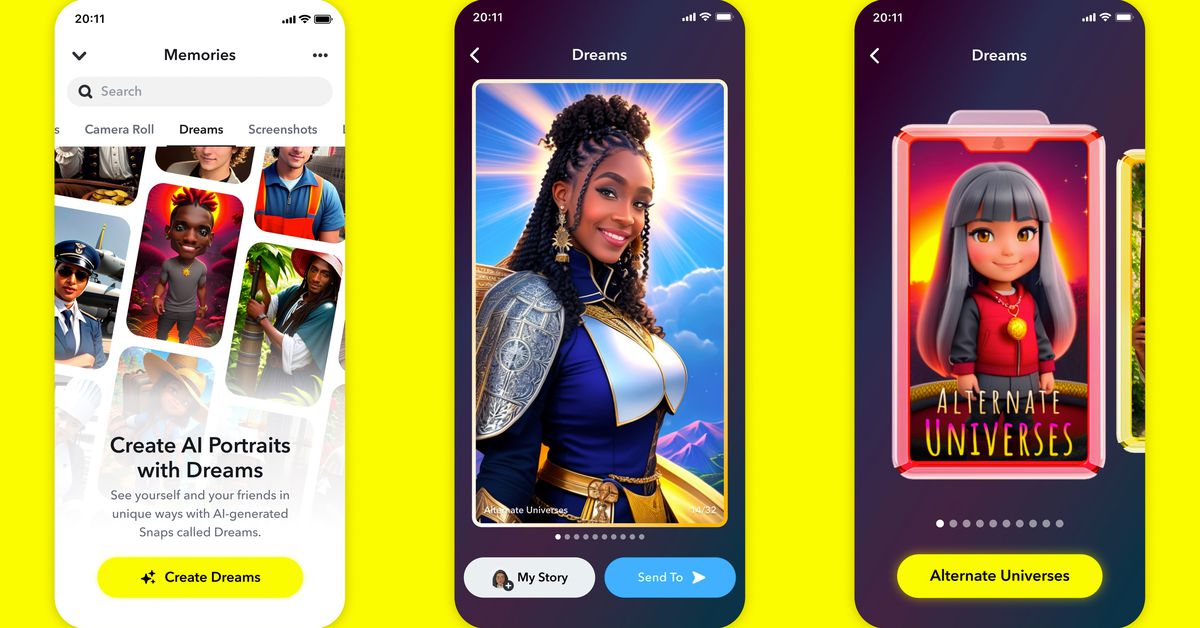/cdn.vox-cdn.com/uploads/chorus_asset/file/24880917/Untitled_1.jpg)
Located in the camera roll section of Snapchat called Memories, Dreams are the company’s own take on the generative AI selfies that one-off apps like Lensa have already popularized. After uploading a series of real-life selfies in the app specifically for Dreams, Snapchat displays a series of eight-photo packs to choose from with themes like doppelgangers or back-to-school.
The first pack of Dreams is free to make and each additional one costs $1 as an in-app purchase. Snapchat users in Australia and New Zealand are getting access to Dreams starting today, followed by access opening up to the rest of the world over the coming weeks.
“A little bit silly and a little bit weird”
“We’ve always approached creating value for the Snapchat community by doing things that are playful, that are fun, [and] that are sometimes a little bit silly and a little bit weird,” Jack Brody, Snap’s VP of product, told me during a recent interview. “And I think Dreams really fits into that.”
The company gave me early access to Dreams to try for this story. After uploading my selfie (a process that will feel familiar to anyone who has set up facial recognition on their phone before) and agreeing to the Dreams terms of service, I selected the fantasy pack to generate. About 30 minutes later, Snapchat pinged me to let me know that my Dreams were ready:
Several of the Dreams I received didn’t really look like me, although there were a couple of funny ones I would consider sharing as a joke. Most of the images didn’t seem to capture my likeness relative to the selfies I’ve made in Lensa and other AI apps. The second doppelganger-themed pack I tried produced results that were all over the place:
For now, Snap doesn’t let users create their own Dreams with custom prompts, though during my chat with Brody, he implied that more AI options would arrive eventually. “If you look at the way we approached AR, for instance, all of the Lenses that we created when we first launched were made in-house,” he said. “Over time, we did open this up to the community and we have a robust process for ensuring that community Lenses conform with our community guidelines and are also loved by the community. So, I think when you look at Dreams, that’s the way we’re approaching it.”
While Snap is using OpenAI’s ChatGPT tech to power its My AI chatbot, Dreams is based on open-source technology and each art style is made by Snap employees, according to Brody. Soon the company plans to let people add their friends to their Dreams — you have to agree to this even before using Dreams in single-player mode.
It’s against the terms of service to use someone else’s selfie to create individual Dreams. That same terms of service also reveals that Sponsored Dreams are coming, which means a company like Disney or Pepsi is probably coming to a Dreams pack near you soon.
Snapchat isn’t talked about as much in pop culture as other social networks, but it’s still huge and growing (at least from a user growth perspective). The company reported 397 million daily users last quarter and, according to Brody, content from Memories is shared between users 280 million times per day. Like with the release of My AI, that means Dreams will likely be the first time that millions of people try this kind of generative AI experience.
Services Marketplace – Listings, Bookings & Reviews
